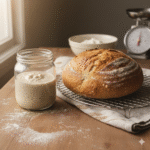Easy Sourdough Recipe With Starter — No-Fail Everyday Loaf
A single medium loaf using an active 100% hydration starter. Crusty exterior, open crumb, ~70% hydration (balanced and forgiving). Two schedule options: same-day (room temp) or slow overnight retard (fridge).
Servings 1 Loaf
Equipment
- 1 Banneton
- 1 Dutch Oven
Ingredients
- 450 g bread flour
- 50 g whole wheat flour optional; you can use 500 g bread flour instead
- 300 g water room temperature
- 100 g active sourdough starter 100% hydration — fed, bubbly
- 10 g fine salt about 1.75 tsp
Instructions
- Feed and check your starter (4–8 hours before or overnight). Use a bubbly, active starter. It should double (or show lots of bubbles) within a few hours after feeding.
- Autolyse (30–60 minutes). In a large bowl, mix the 300 g water with the 500 g total flour (450 g bread flour + 50 g whole wheat if using) until there are no dry patches. Cover and rest 30–60 minutes.
- Why: autolyse hydrates flour and helps gluten development.
- Add starter + salt (5 minutes). Add 100 g starter and 10 g salt. Mix until incorporated — squeeze and fold the dough until homogeneous. Cover.
- Bulk fermentation with stretch-and-folds (2–4 hours at ~75°F / adjust for temp).
- Do 4 sets of stretch-and-folds every 20–30 minutes during the first 1.5–2 hours. To stretch-and-fold: wet hands, lift one side and fold over; rotate bowl and repeat 4×.
- After the last fold, let dough rest undisturbed until it has increased by ~20–40% and shows bubbles at the surface. (Warmer temps shorten time; cooler temps lengthen it.)
- Option A — Same day schedule: Bulk ferment ~3–4 hours total, then shape and final proof 1–2 hours (or until ~80% rise), bake.
- Option B — Overnight retard (recommended for flavor): After initial bulk and folds (1.5–2 hours), shape lightly and place in a floured banneton, cover, and refrigerate overnight (8–16 hours). Bake next day from cold.
- Shape: Turn dough onto a lightly floured surface, pre-shape into a round, rest 15–20 minutes, then final shape into a tight boule. Place seam-side up in a floured banneton (or bowl lined with linen).
- Final proof: Room temp 1–2 hours until puffy (Option A) or fridge 8–16 hours (Option B).
- Preheat oven + bake: Preheat oven to 475°F (245°C) with a Dutch oven inside for at least 45 minutes. Score the loaf, transfer dough seam-side down into hot Dutch oven, cover, bake 20 minutes covered, then reduce to 450°F (230°C) and bake 20–25 minutes uncovered until deep brown and hollow-sounding. Internal temp ~205–210°F when done.
- Cool: Let cool at least 1 hour before slicing to finish crumb set.
Notes
Troubleshooting & quick fixes
- Starter not bubbly? Feed 2–3 times or wait until it doubles before using.
- Too dense crumb? Try longer bulk fermentation (warm place), gentler shaping, or slightly higher hydration.
- Flat loaf after scoring? You may have overproofed — shorter final proof next time.
- Too sour? Shorten retard time or bake sooner after final proof.
